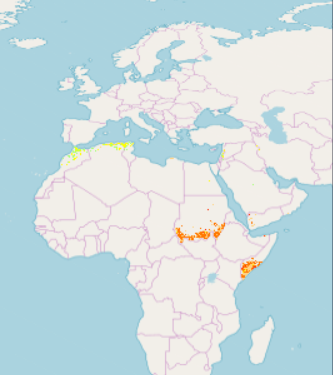dataset
Type of resources
Available actions
Topics
Keywords
Contact for the resource
Provided by
Years
Formats
Representation types
Update frequencies
status
Scale
Resolution
-
The main sources of information for the species distribution are the habitat description and geographic range contained in the published FAO Catalogues of Species (more details at http://www.fao.org/fishery/fishfinder ). Terms used in the descriptive context of the FAO Catalogues were converted in standard depth, geographic and ecological regions and inserted into a Geographic Information System.
-
**Table content** - Year - INDICATOR - SPECIES - VALUE - FLAG - UNIT **Value assigned to No-data**:m
-

Part of the Integrated Vulnerability Assessment in the Arab Region, this 1km pixel resolution raster dataset provides a representation of Vulnerability for Biodiversity and Ecosystems:Area Covered by Wetlands sub-sector, in the Middle East and North Africa Region, 1986-2005 reference period. Pixel values were classified according to level of vulnerability, from low 1 to high 10. Vulnerability is a concept used to express the complex interaction of climate change effects and the susceptibility of a system to its impacts. The integrated vulnerability assessment methodology is based on an understanding of vulnerability as a function of a system’s climate change exposure, sensitivity and adaptive capacity to cope with climate change effects, consistent with the approach put forward by the Intergovernmental Panel on Climate Change (IPCC) in its Fourth Assessment Report (AR4). It adopts the time periods generally used by the IPCC and other regional climate modelling experiments, and runs climate simulations based on future time periods that are compared with a historical reference period.
-
The FAO major fishing areas for statistical purpose are defined by the CWP handbook of fishery statistical standards available at http://www.fao.org/fishery/cwp/handbook/h/en
-
The main sources of information for the species distribution are the habitat description and geographic range contained in the published FAO Catalogues of Species (more details at http://www.fao.org/fishery/fishfinder ). Terms used in the descriptive context of the FAO Catalogues were converted in standard depth, geographic and ecological regions and inserted into a Geographic Information System.
-

Part of the Integrated Vulnerability Assessment in the Arab Region, this 1km pixel resolution raster dataset provides a representation of future change in vulnerability for Biodiversity and Ecosystems sector, in the Middle East and North Africa Region. The Raster grid was generated for moderate representative concentration pathway (RCP4.5) emission scenario developed by the Intergovernmental Panel on Climate Change (IPCC) for time period End-Century (2081-2100). Pixel values are classified according to level of vulnerability, from low 1 to high 10. Vulnerability is a concept used to express the complex interaction of climate change effects and the susceptibility of a system to its impacts. The integrated vulnerability assessment methodology is based on an understanding of vulnerability as a function of a system’s climate change exposure, sensitivity and adaptive capacity to cope with climate change effects, consistent with the approach put forward by the IPCC in its Fourth Assessment Report (AR4). It adopts the time periods generally used by the IPCC and other regional climate modelling experiments, and runs climate simulations based on future time periods that are compared with a historical reference period.
-

Part of the Integrated Vulnerability Assessment in the Arab Region, this 1km pixel resolution raster dataset provides a representation of future change in vulnerability for People:Water Available for Drinking sub-sector, in the Middle East and North Africa Region. The Raster grid was generated for high representative concentration pathway (RCP8.5) emission scenario developed by the Intergovernmental Panel on Climate Change (IPCC), for future time period Mid-Century (2046-2065). Pixel values are classified according to level of vulnerability, from low 1 to high 10. Vulnerability is a concept used to express the complex interaction of climate change effects and the susceptibility of a system to its impacts. The integrated vulnerability assessment methodology is based on an understanding of vulnerability as a function of a system’s climate change exposure, sensitivity and adaptive capacity to cope with climate change effects, consistent with the approach put forward by the IPCC in its Fourth Assessment Report (AR4). It adopts the time periods generally used by the IPCC and other regional climate modelling experiments and runs climate simulations based on future time periods that are compared with a historical reference period.
-
The FAO major fishing areas for statistical purpose are defined by the CWP handbook of fishery statistical standards available at http://www.fao.org/fishery/cwp/handbook/h/en
-
The FAO major fishing areas for statistical purpose are defined by the CWP handbook of fishery statistical standards available at http://www.fao.org/fishery/cwp/handbook/h/en
-
The main sources of information for the species distribution are the habitat description and geographic range contained in the published FAO Catalogues of Species (more details at http://www.fao.org/fishery/fishfinder ). Terms used in the descriptive context of the FAO Catalogues were converted in standard depth, geographic and ecological regions and inserted into a Geographic Information System.
 FAO Map Catalog
FAO Map Catalog